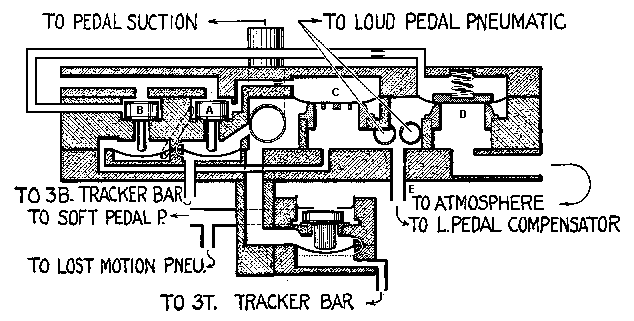|
Ampico 'B' Loud Pedal Valve (page 27)
Ampico B Loud Pedal Valve Block

LOUD AND SOFT PEDAL VALVES - Fig. 14
Ampico B Loud Pedal Valve Block
Fig. 14 is the loud and soft pedal valve block.
It has been somewhat distorted in the position of its various parts so
as to illustrate more clearly its construction and operation.
Two pouches C and D are employed to
operate the loud pedal pneumatic: C to admit suction to collapse
it, and D to admit atmosphere to open it.
Suction pouch C is operated by an inside
primary valve A which is controlled from the 3B hole [Loud
Pedal] in the tracker bar.
The atmosphere pouch D is operated by an
inside primary valve B which is controlled by the primary valve
A.
The pouch C and its primary valve A
are supplied with suction from the pedal regulator.
Pouch D and its primary valve A are
supplied with suction, temporarily generated by the pedal pneumatic as
it opens.
When the 3B tracker hole is opened, the primary
valve A raises and admits suction to the pouch C, which in
turn raises from its seat and admits suction to the pedal pneumatic.
This suction, aided by a spring, holds pouch D
against its seat, thereby sealing the atmosphere passage to the pneumatic.
When the pneumatic is fully closed, the suction
in the chamber under the pouch C becomes the same as that above
it, and the pouch is in balance.
The suction in the pneumatic now supplies the pouch
chamber of valve B, but as its pouch is balanced by the suction
from valve A, which is up, the valve B remains down.
When the tracker hole 3B is closed, the valve
A
drops and admits atmosphere to the pouch C, thereby pressing it
against its seat and cutting off suction to the pneumatic.
At the same time, atmosphere from the valve A
is admitted to the under side of the pouch of valve B, and suction
generated by the pedal pneumatic as it opens raises the valve B.
This admits generated suction to the pouch D, which lifts from its
seat and admits atmosphere to the pneumatic which opens.
During the time that the pneumatic opens, it generates
suction which holds the pouch D away from its seat. However,
as soon as the pneumatic is fully opened, it ceases to generate suction
and the valve B and pouch D return to their seats.
The valves are now in position for the next perforation
in the note sheet.
Constrictions are placed in the tubes leading to
pouches C and D to control their speed of operation.
This mechanism has been designed to obtain rapid
and quiet damper operation.
The dampers should be adjusted so that when they
are raised the strings are fully cleared by the wedge-shaped dampers.
This adjustment is made by a stop screw in the moveable
board of the pneumatic.
Pedal Compensation

When the loud pedal pneumatic is collapsed, suction from the
pneumatic is admitted to the under side of pouch H in the 1st Intensity
Adjuster Block, Fig 5.
The pouch is pulled away from its seat opening the by-pass I
around the constriction J as well as a small channel N leading
to atmosphere.
This allows more atmosphere to enter the chamber C of
the expression regulator as shown in Sketch 4, and somewhat reduces the
suction therein. The suction in the wind chest is also reduced by
the same amount.
This reduction pressure when the dampers are raised is necessary
at low pressures because a note struck with the damper raised is louder
than the same note struck with the damper at rest.
The amount of this compensation is controlled by the position
of the two screws L and M. They are adejusted at the
factory and should never be altered.
Fig. 5 shows one pouch, whereas two pouches are used, one for
the bass and one for the treble.
The above compensation is one of a number found in the New Ampico
which helps to produce an outstanding evenness and smoothnemss of playing.
Reproduced from page 27-28
The Ampico Service Manual 1929,
Copyright 1929 by American Piano Company
|
 Gallery
Gallery
 Tech
Tech
 Ampico
Ampico
 amp27.htm
amp27.htm

